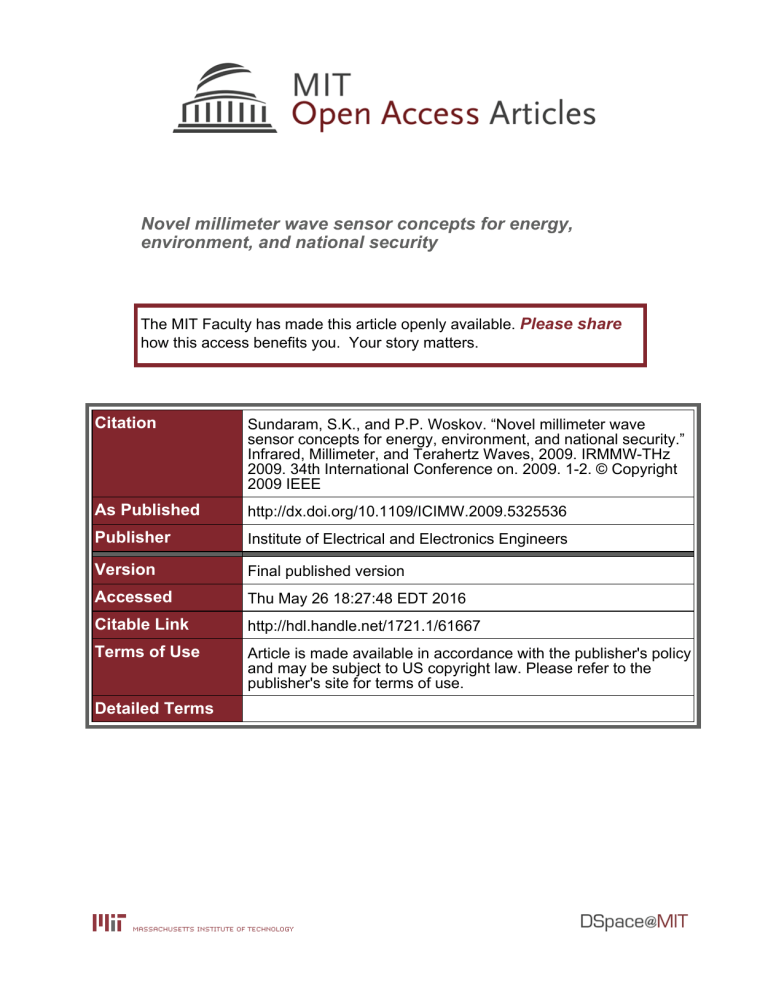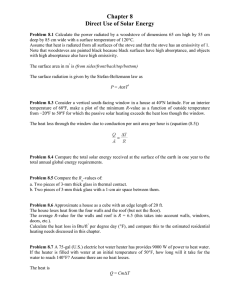Novel millimeter wave sensor concepts for energy, environment, and national security

Novel millimeter wave sensor concepts for energy, environment, and national security
The MIT Faculty has made this article openly available. Please share how this access benefits you. Your story matters.
Citation
As Published
Publisher
Version
Accessed
Citable Link
Terms of Use
Detailed Terms
Sundaram, S.K., and P.P. Woskov. “Novel millimeter wave sensor concepts for energy, environment, and national security.”
Infrared, Millimeter, and Terahertz Waves, 2009. IRMMW-THz
2009. 34th International Conference on. 2009. 1-2. © Copyright
2009 IEEE http://dx.doi.org/10.1109/ICIMW.2009.5325536
Institute of Electrical and Electronics Engineers
Final published version
Thu May 26 18:27:48 EDT 2016 http://hdl.handle.net/1721.1/61667
Article is made available in accordance with the publisher's policy and may be subject to US copyright law. Please refer to the publisher's site for terms of use.
Novel Millimeter Wave Sensor Concepts for
Energy, Environment, and National Security
S. K. Sundaram a and Paul P. Woskov b a Pacific Northwest National Laboratory, Richland, WA 99352, USA b Massachusetts Institute of Technology, Cambridge, MA 02139, USA
Abstract —Millimeter waves are ideally suited for sensing and diagnosing materials, devices, and processes that are broadly important to energy, environment, and national security. Thermal return reflection (TRR) techniques that detect and use thermal emission as a probe to diagnose materials and systems make possible accurate noncontact thermal analysis measurements that can resolve emissivity and temperature simultaneously. Scientific basis of TRR, 2-D and potentially 3-D measurements, and applications of TRR are discussed.
M
I. I NTRODUCTION AND B ACKGROUND
illimeter wavelengths provide a unique capability for in situ thermal analysis of materials by being long enough to penetrate dust, smoke, and otherwise optically obscure propagation paths and materials yet short enough to enable focusing and manipulating of the signals for spatially resolved applications. Thermal emission signals from a material or surface are proportional to the product of the emissivity and temperature ( H T) of the material or surface that is viewed. The emissivity is related to material phase state, chemistry, and molecular structural characteristics such as corrosion and creep that typically depend on temperature. Methods that can resolve the emissivity and temperature are of general interest to thermal analysis, particularly at high temperatures when pushing the limits of material applications. An active millimeter-wave pyrometer that can measure emissivity along with temperature has been demonstrated 1 . The main limitation of that approach was that the leaked local oscillator signal used to probe the viewed emissivity was coherent. Therefore, a standing-wave interference effect in the measurement setup had to be accounted for. We have demonstrated that incoherent thermal emission from the viewed sample can be redirected back to the sample and used to probe its emissivity, and consequently, resolve the parameters of the thermal emission product
H
T without standing wave uncertainties. The analytical basis has been derived for determining these parameters using the thermal return reflection (TRR) method 2 .
II. A NALYTICAL B ASIS
The previously derived TRR method 2 has been extended to allow for non opaque specimens as shown in Figure 1. The receiver views a specimen (S) through a beamsplitter (BS) and waveguide system (WG). The specimen thermal emission is used as a probe from the front and behind by mirrors TRR M and SRR M, respectively. The analysis requires taking into account all of the sources and losses of signal in the field of view of the receiver. Each component has associated with it an emissivity ( H ), temperature ( T ), transmission factor ( W ), and reflectivity ( r ). The analysis now allows for a non opaque specimen with a single pass transmission factor of
W s
. If a component is at room temperature, then its emissivity and temperature will cancel out as in the case of the beamsplitter.
The analytical results for the measured temperature at the receiver for the various thermal probing cases are given by:
T eff
W H H
T eff s
1
T r s
T eff
W W W W 2 s bs wg
(1)
(2)
T ' eff 1
T eff
W
N r r W
(3) where T eff
, T s eff
, and T ' eff are the MMW temperatures measured at the receiver without any thermal feedback, with only feedback by SRR M, and with only TRR M reflection, respectively, T wg
and T s
are the waveguide and specimen temperatures,
H wg
and transmission related by
W
H wg
are the waveguide emissivity and wg
1 W wg
,
H s ,
W s
, and r s
are the emissivity, transmission, and reflectivity of the specimen where in the limit for a completely opaque specimen
H s
1 r s
, r bs is the beamsplitter reflectivity and
W
N
is the return emission coupling factor taking into account reflected field of view divergence and alignment. A fourth equation is obtained for simultaneous reflection by both mirrors by replacing T eff in
Eq. 3 by T s eff
. For a specimen that is not completely opaque or transparent the emissivity depends on both the specimen absorption and reflectivity. The set of four equations makes possible the determination of the specimen temperature, emissivity, and coupling factor where the emissivity depends on both the specimen bulk absorption and surface reflectivity.
These parameters are resolved for the direction of view and for the polarization of the receiver system. Using the layout illustrated in Figure 1 as a building block additional spatial and
TRR M r s
, H s
, T s
SRR M r bs
, W bs
S d
W
N
W wg
, H wg
WG
, T wg
BS
Receiver
Figure 1. Configuration and key parameters for MMW thermal analysis of a specimen (S) in one spatial dimension polarization dimensions can be added to study specimens with
complex anisotropic geometries. Multiple receives could also be added to one dimension with different fixed thermal probing configurations for real time fast transient analysis of the specimen behavior under controlled changing environmental conditions such as temperature, atmosphere, or stress.
III. D ISCUSSION
We extend our approach to 3-D measurements. The emissivity ( H ), temperature ( T ), and transmission factor ( W ) of waveguides for X, Y, and Z directions can be used and reflectivity ( r ) can be determined following the three directions
(Figure 2). Losses due to each waveguide and other components can be corrected so that three respective receivers measure the true transmission along each direction. Though three identical optics and receiver systems could be fabricated and used, TRR will be used to calibrate and correct for losses or any alignment errors. This approach can be used in two different modes: 1) directly viewing from three-different directions (3-D viewing) and 2) splitting the signal three ways using 3-D optics to track three different properties or parameters (3-D signaling). Equation 3 can be rewritten for
3-D application, e.g., for a simple case of only TRR M reflection:
T 3 eff
D
1 W k x
T eff x r s x r bs
2 x
W 2 wg x
1 W k y
T eff y r s y r 2 bs y
W 2 wg y
1 W k z
T eff z r s z r 2 bs z
W 2 wg z
(4) environment, and national security applications For example, the development of Generation IV very high temperature nuclear energy reactor (VHTR) technology depends on the development and characterization of high temperature anisotropic graphite and alloy materials that can reliably meet the diverse fuel and structural requirements in extreme environments. The thermal dynamics and properties of anisotropic ceramic composite, carbon fiber-reinforced carbon
(CfC) and SiCf/SiC materials of relevance to VHTR technology are not well known using orthogonally polarized dual beam MMW measurements,
In the case of environment application, we have demonstrated 2-D temperature distribution of cold cap in a joule-heated melter used for melting of simulated nuclear waste glass melting (vitrification) [3]. This can potentially be extended to 3-D measurement to track emissivity/temperature changes in the plenum or inside the bulk material or melt.
1000
800
600 o
C
More detailed analytical solutions for specific applications can be derived as shown in [2].
Sample surface or 3-D optics
W H
Z
, s
Z
,T s
Z
0
F
90
View Angle (deg)
2.5
400
1.0
4.0
5.5
Distance from Center (in.)
Figure 3. 2-D Temperature profile inside the melter [3]
W H y
, ,T y s y
W H x
, s x
,T s x
Emissivity of moving body or material or gas space can be tracked for national security applications. These can be translated into 3-D temperature, which will be valuable for detecting moving targets, strange movements, and hidden objects. By incorporating time delay in one or more of the directions, one can capture situational dynamics in real time.
These data can potentially be fused with MMW imaging technologies to confirm and validate data or information critical to intelligence community.
Figure 2. Conceptual scheme of 3-D measurements
Also new sensor concepts are possible based on emit-probe and pump-probe modes to further broaden its applications. In its 3-D manifestation of this technique, one can track three different parameters or view/measure at three different directions (x, y, and z). This shows promise for measuring temperature (T) - position (x) - time (t) simultaneously in real time leading to T-x-t diagrams that can be exploited for spatial resolution of emissivity or stability over a function of time. The
3-D manifestation can be implemented by simply connecting three MMW receivers pointed at the sample from x, y, and z directions for 3-D viewing. Alternatively, 3-way splitter can be designed and implemented.
New materials sensor technologies are needed for energy,
R EFERENCES
[1] P. P. Woskov, D. R. Cohn, D. Y. Rhee, P. Thomas, C. H. Titus, and J. E.
Surma, “Active Millimeter-Wave Pyrometer”, Rev. Sci. Instrum., vol. 66,
4241-4248, 1995.
[2] P.P. Woskov and S. K. Sundaram, “Thermal return reflection method for resolving emissivity and temperature in radiometric methods”, J. Appl.
Phys., vol. 92, 6302-6310, 2002.
[3] S. K. Sundaram, P.P. Woskov, J.S. Machuzak, and W.E. Daniel, Jr., “Cold
Cap Monitoring using Millimeter Wave Technology,” in Environmental
Issues and Waste Management Technologies in the Ceramic and Nuclear
Industries VII, Ceramic Transactions, Volume 132, Editors: S. K.
Sundaram, Gary Smith, and Dane R. Spearing, The American Ceramic
Society, ISBN 1-57498-146-3, pp. 203-213, April 2002.





